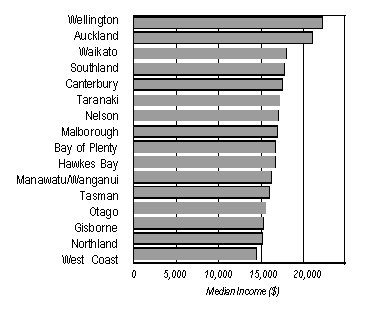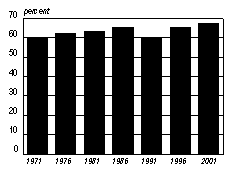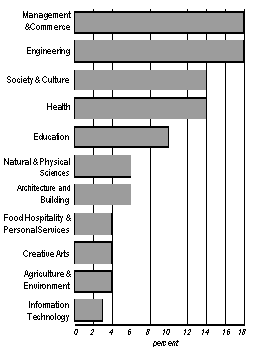

10 April 2002
|
Work, Education and Income These figures are taken from the Statistics New Zealand "snapshot" of work, education and income data collected in the 2001 Census
3 IN 4 OF THOSE WORKING WERE EMPLOYED FULL TIME 3 1 IN 3 ADULTS HAD POST-SCHOOL QUALIFICATIONS PEOPLE IN THE WELLINGTON REGION HAD THE HIGHEST MEDIAN ANNUAL INCOME
The median annual income was $18,500 for the year ended 31 March 2001. People in the Wellington region had the highest median annual income at $22,400. The Wellington region had the highest portion of people earning an annual income of over $100,000, with 1 in 25 people. The median income for males was $24,900 – more than $10,000 above that of $14,500 for females. Males in the 40 to 44-year age group had the highest median income at $35,900. The highest median income for females was in the 45 to 49-year age group at $22,000. The $10,001–$15,000 income group was the most common, with 1 in 6 people (395,106). The $30,001–$40,000 income group had 1 in 8 people (311,598).
Wages and salaries were the most common source of income, with nearly 6 in 10 people receiving income from this source. 1 in 6 people received income from self-employment. With changes in eligibility, the number of people receiving New Zealand Superannuation or Veterans Pension declined from 441,045 in 1996 to 419,964 in 2001. 1 in 6 people received income from New Zealand Superannuation or Veterans Pension. More than 9 in 10 people aged 65 years and over received income from New Zealand Superannuation or Veterans Pension.
By Region 
62 percent of adults were employed in 2001, compared with 60 percent in 1996. 3 in 4 of those working were employed full time. The number of people employed full time increased by 6 percent (75,351) from 1996 to 2001. The number of people employed part time increased by nearly 6 percent (21,108) from 1996 to 2001. Nearly 3 in 4 part-time workers were female. 1 in 3 adults (33 percent) were not in the labour force. This rate was 40 percent in 1971. The labour force participation rate was 67 percent. The most common occupation was sales assistant, with 85,530 people. The manufacturing industry had the most workers, with 1 in 7 (223,806). 1 in 6 workers in the agriculture, forestry and fishing industry were from the Waikato region. 4 in 10 workers in the finance and insurance industry were from the Auckland region. 1 in 7 workers in the mining industry were from the Taranaki region and 1 in 8 from the West Coast region. On census day in 2001, 1 in 10 people worked at home, while almost 2 in 3 travelled to work in a private or company vehicle. On census day in 2001, 1 in 20 people walked or ran to work.

There has been a drop in the number of people with no qualifications, from 1 in 3 in 1996 to 1 in 4 in 2001. School Certificate in one or more subjects (or National Certificate level 1) was the highest school qualification for most people, with 1 in 5 adults (517,830). 1 in 3 adults had post-school qualifications. 1 in 5 adults had a vocational qualification (such as the New Zealand Certificate of Engineering), while 1 in 8 had a degree as their highest post-school qualification. Nearly 1 in 5 adults in the Wellington region had a degree as their highest qualification. The most common field of study for post-school qualifications was nursing, with 58,170 people. The information technology field of study for post-school qualifications had 24,009 people. Broad Field of Study  |
SUMMARY INCOME LEVELS INCOME SOURCES MEDIAN INCOME BY REGION WORK QUALIFICATIONS HIGHEST POST-SCHOOL QUALIFICATION LABOUR FORCE PARTICIPATION RATE
|